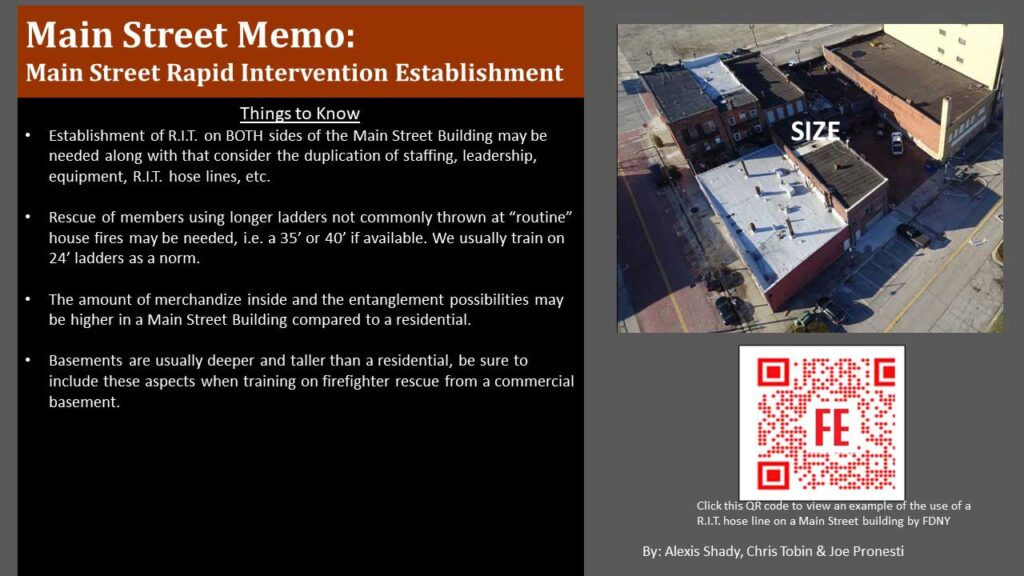By Joe Pronesti, Chris Tobin, and Alexis Shady

A recent Tony Carroll “Mayday Monday” article stated that commercial building fires account for just 7% of our fire problem, so this makes it an even bet that most fire departments experience and focus their training on the residential building fire and, along with that, rapid intervention from these structures.
When was the last time you were on the fire scene with more than one dedicated team whose sole focus was the rescue of firefighters? Well, when you arrive to a working fire in a block of Main Street buildings and your department has arrived with the “typical” small- to mid-size response of say, four engines and a ladder/quint, it can be a challenge to set up one rapid intervention team (RIT), let alone two. That is what will confront an incident commander at the scene of a Main Street fire, especially one that is in the middle of the block.
This month’s Main Street Memo highlights a few differences that can be found between RIT for a residential house fire vs. a Main Street fire. Our concerns probably are going to be the same—lost firefighters, collapse through the floor, etc.—but it’s the sheer size of the building that will change how you set up and staff a Main Street RIT.
Some items to consider:
- Staffing and leadership of the RITs: You most likely will need at least two crews, one on A side and one on the Charlie with at least eight-12 firefighters, and this is just a starting point.
- Ladders: When was the last time you trained on throwing a 35’ ladder with limited staffing, or making a rescue on a ladder that size?
- Hoselines for RIT: Included in this month’s memo is an excellent example of the utilization of a RIT line at a fire commanded by FDIC instructor and Fire Engineering Author Jerry Tracy.
- Having enough rescue equipment available for two sides of the Main Street building: Do you have enough saws, air supply, ladders, etc.?
- Apparatus locations: Do you have an engine and a ladder company on the Charlie? Is there enough room? And so forth.
There are many items to consider, and when our “bread and butter” response consists of a 2,500-square-foot residential, don’t be pigeonholed when you arrive at your Main Street fire and simply check the RIT box off on the command worksheet and think you’re done.
The time to prepare is, as always, before your fire. Get into your buildings. Train on rescues of firefighters from taller basements/cellars (i.e. a 12-foot high cellar compared to a typical 8-foot high) and making firefighter rescues using multiple 35-foot or higher ladders. How many small- to mid-size departments carry a Bangor ladder? With the proliferation of quint-style apparatus, many departments arrive on their Main Street with a single 35-foot ladder.
As with all our memos, this month’s training bulletin is simply to get you and your members thinking about some of the obstacles you may encounter on the fireground.
Download this training bulletin as a PDF (2 MB).
JOSEPH PRONESTI is the chief of the Elyria (OH) Fire Department. He is a graduate of the Ohio Fire Chiefs’ Executive Officer program and a lead instructor at the Cuyahoga (OH) County Community College Fire Academy. He is a frequent contributor to fire service publications and sites, including Fire Engineering and FirefigherNation.com.
CHRISTOPHER TOBIN is a firefighter assigned to St. Louis (MO) Fire Department Rescue 2.
ALEXIS SHADY is a firefighter/paramedic with the University City (MO) Fire Department.

